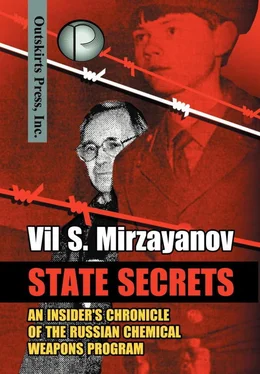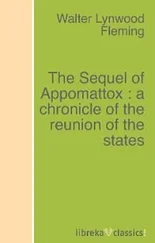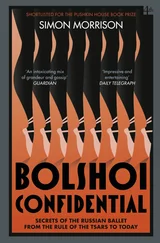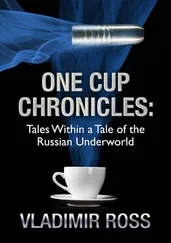Just a year earlier, the division for producing agent CS had been set up in a local chemical plant in Slavgorod. I was not able to participate in this opening, because I became ill in December of 1976. I had to give away my plane ticket, so my assistants Yuri Bugrov and Boris Dubin went there to introduce the methods and analytical procedures that were needed. Unfortunately, even though I had an official release from a doctor, the director of GOSNIIOKhT, my immediate supervisor Aleksei Beresnev and the aforementioned Sergei Smirnov considered that my illness was not sufficient reason for my refusal to go on this trip. I was given an “official reprimand”.
I participated fully in the start-up of the Novocheboksary pilot plant, and my GC method of determination of micro-concentrations of agent CS in the air (at the minimum permissible level of concentration) was adopted, practically unaltered. The reason for this was that the other method proposed by Brovkin’s laboratory was extremely unselective and disorienting. However, the successful introduction of my methods required a stable working GC with an electron-capturing detector.
Up to this time, the domestically produced Tsvet-100 chromatograph had proven to be a pretty good piece of equipment, but it was running in a very unstable way, with its sensitivity constantly changing. Through my work experience at GOSNIIOKhT, I already knew that this task could only be resolved with the help of an American Varian 1800 chromatograph. So, I ordered this instrument for the job, and I defended my choice, in spite of strong pressure from Guskov and the Volgograd institute “Giprosynthesis”, which was designing the pilot plant. They worked in every possible way to dissuade me from my proposal, arguing for a long time that I should use only “domestically produced equipment for the defense industry”. I would have been happy to comply, if I had not known about the unstable characteristics of domestic equipment. I insisted on my own way in this case, since I was the author of the procedures. I had the exclusive right to guarantee the trustworthiness of the analysis only with the equipment that I had chosen.
Leonid Kostikin, Deputy Director for Science and Igor Gabov, Deputy Chairman of Main Administration “Soyuzorgsynthesis” of the Ministry of Chemical Industry ran the pilot plant start-up. My American instrument could not be reproached for the way it worked, and we had practically no problems with the analyses of the air probes. Air was sampled from the room where we worked and also from under the roof of the plant.
It was impossible to avoid heated arguments about the concentrations of air that was analyzed. Generally, the results showed us that the concentration of agent CS in the work room exceeded the limit of permissible concentrations (LPC). The boss did not agree with this. However, when we discovered a substantial concentration in the corridor leading from his laboratory in the plant, he was very displeased. This was because these rooms were considered to be located outside the range of the agent’s influence. “This cannot be!” exclaimed my opponent.
Such obstructionism was already familiar to me, because I had already collided forcefully with the chief engineer of the experimental plant at GOSNIIOKhT, Victor Zhakov, during the testing of the technology of agent CS production. The levels in the workroom at that time frequently exceeded the LPC. Zhakov was more than happy to try to discredit my methods of analysis, but it turned out that he was a bit ignorant about the adsorption basics.
He tried to compromise my procedures (which the workers were using to check the air) by ordering that the air sampling be taken after a day had passed during which the ventilation in the workroom had been shut down. At this point, we made a surprising discovery: the concentration of agent CS in the still air without ventilation was greater than it was on working days with the ventilation running. This result was simple to explain. Once it had adsorbed on the surfaces in the room – the walls, the equipment and so forth – the irritant, which had a relatively low volatility, was then slowly desorbing. Naturally during intensive ventilation, the concentration of agent CS was diluted by a large volume of air. This concentration of CS was less than that which came from the relatively low volume of practically static air. We were even successful in modeling this phenomenon on the lab bench, demonstrating that our explanation was correct.
Surprisingly, when we made our methods and procedures for analysis of the air more accurate, the ill-will of the top leadership became stronger. This reminds me of an incident connected with the discussion in a section of the Science Council of my patent claim on the GC method of determination of micro-concentrations of agent CS in the air.
At this meeting, Deputy Director Guskov unexpectedly came out against my invention. Without having any knowledge of the essence of the problem, he peremptorily declared that my proposal for concentrating the adsorbent, using small glass beads, could not work because the vapor of CS could not adsorb. I repeatedly had proven the validity of my proposal with positive experimental results. The Deputy Director used his great power, and I found myself in a very delicate situation. However, without any fear, I decided to defend my invention and brought forth a brief report about the basics of the dynamics of adsorption.
After this, the section defended my proposal in an open vote, and a year later I received a patent on my invention. All my documents, including the actual patent carried the code “Top secret”, “Series F”.
According to U.S.S.R. patent law at that time, the inventor was supposed to be rewarded for his method of analysis. The size of the remuneration was calculated by a complicated method, with numerous correction factors, and was fixed by a special commission. The author of the patent had to demonstrate the validity of the correction factors to this commission, and naturally this is where all the battles developed. Usually the author valued his work on a high level according to the scale of factors, while the rank and file of the science commission, most of whom had never invented anything in their entire lives, often envied the success of the author and came out against him.
In the end, everyone had to compromise and the remuneration was fixed, but it didn’t end there. The commission’s decision had to be approved by the First Deputy Director, who signed the financial documents. Here he was guided by his own considerations which were clear only to him, and by the amount of money which came in yearly from the Ministry of Chemical Industry specifically for inventions and proposals and for improving production.
After I received an award for the appropriate sum by the commission, I set out for Guskov’s office. I was surprised that he approved the commission’s decision without any discussion. Now and then you can misunderstand someone you already considered in a negative way. How can you so simply judge someone after that?
In Novocheboksary, we were able to demonstrate experimentally that the poisoning of the corridor was caused by the transport of agent CS on the clothing of people who were working in gas masks in the reaction chamber area, where the concentrations of the agent were extremely high.
My work experience at Post Office Box 4019 on the production of poisonous boranes helped me resolve this complicated problem. We had discovered traces of CS in the snow on the roof of the plant, and also on the ground close to the plant. It was said that complete isolation of the production of chemical agents from the environment was practically an impossible task.
Unfortunately, I must say, that Sergei Smirnov, who was the author of the technology in the plant in Novocheboksary, was most memorable for his negative character traits, such as the tendency to inform on his colleagues for no reason at all. (This was not his worst feature.) Practically no one was really sure that he was not exaggerating a hundredfold when he was informing. His allegations could be brought to a higher boss, or even the Deputy Director of the Security Regime.
Читать дальше












